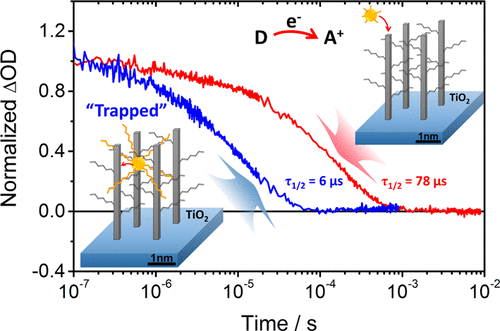当前位置:
X-MOL 学术
›
J. Am. Chem. Soc.
›
论文详情
Our official English website, www.x-mol.net, welcomes your
feedback! (Note: you will need to create a separate account there.)
Exploiting intermolecular interactions between alkyl-functionalized redox active molecule pairs to enhance interfacial electron transfer
Journal of the American Chemical Society ( IF 14.4 ) Pub Date : 2018-09-27 , DOI: 10.1021/jacs.8b09070 Inseong Cho 1 , Mizuho Koshika 2 , Pawel Wagner 1 , Nagatoshi Koumura 3 , Peter C. Innis 1 , Shogo Mori 2 , Attila J. Mozer 1
Journal of the American Chemical Society ( IF 14.4 ) Pub Date : 2018-09-27 , DOI: 10.1021/jacs.8b09070 Inseong Cho 1 , Mizuho Koshika 2 , Pawel Wagner 1 , Nagatoshi Koumura 3 , Peter C. Innis 1 , Shogo Mori 2 , Attila J. Mozer 1
Affiliation

|
The strategies to enhance electron transfer rates between redox-active, light-harvesting molecules attached to semiconductor surfaces and redox mediators in solution by modifying molecular structure are not fully investigated yet. Therefore, the design of molecules with controlled electron transfer rates remains a challenge. The aims of this work are to quantify the effect of long alkyl chain substitution on the electron transfer from cobalt(II/III) tris(2,2'-bipyridine) to organic molecules containing carbazole and thiophene and to demonstrate that alkyl chains can be used to enhance electron transfer between donor-acceptor pairs. To this end, we study the effect of using a combination of donor and acceptor molecules with and without alkyl chains on electron transfer kinetics. Using transient absorption spectroscopy, we show that when only the molecules or the mediators have long alkyl chains, electron transfer is slightly blocked as expected. Counterintuitively, electron transfer is up to 13 times faster when long alkyl chains are attached to both the redox-active molecules and the redox mediators. The faster electron transfer is explained by an alkyl-alkyl chain interaction between the donor/acceptor, leading to the proximity (trapping) of the redox mediators close to the π-conjugated backbone of the molecules. These results suggest that intermolecular interactions can be used to enhance the electron transfer rates significantly even with well-established insulating alkyl chains attached to molecules without changing the electrochemical driving force.
中文翻译:

利用烷基官能化氧化还原活性分子对之间的分子间相互作用来增强界面电子转移
通过修改分子结构来提高附着在半导体表面的氧化还原活性、光捕获分子和溶液中氧化还原介质之间的电子转移速率的策略尚未得到充分研究。因此,设计具有受控电子转移速率的分子仍然是一个挑战。这项工作的目的是量化长烷基链取代对从钴 (II/III) 三(2,2'-联吡啶) 到含有咔唑和噻吩的有机分子的电子转移的影响,并证明烷基链可以用于增强供体-受体对之间的电子转移。为此,我们研究了使用带有和不带有烷基链的供体和受体分子的组合对电子转移动力学的影响。使用瞬态吸收光谱,我们表明,当只有分子或介体具有长烷基链时,如预期的那样,电子转移会略微受阻。与直觉相反,当长烷基链连接到氧化还原活性分子和氧化还原介体时,电子转移速度最多可提高 13 倍。更快的电子转移可以通过供体/受体之间的烷基-烷基链相互作用来解释,导致氧化还原介质靠近(捕获)分子的 π 共轭骨架。这些结果表明,即使在不改变电化学驱动力的情况下,分子间相互作用也可用于显着提高电子转移速率,即使是在分子上连接了完善的绝缘烷基链。与直觉相反,当长烷基链连接到氧化还原活性分子和氧化还原介体时,电子转移速度最多可提高 13 倍。更快的电子转移可以通过供体/受体之间的烷基-烷基链相互作用来解释,导致氧化还原介质靠近(捕获)分子的 π 共轭骨架。这些结果表明,即使在不改变电化学驱动力的情况下,分子间相互作用也可用于显着提高电子转移速率,即使是在分子上连接了完善的绝缘烷基链。与直觉相反,当长烷基链连接到氧化还原活性分子和氧化还原介体时,电子转移速度最多可提高 13 倍。更快的电子转移可以通过供体/受体之间的烷基-烷基链相互作用来解释,导致氧化还原介质靠近(捕获)分子的 π 共轭骨架。这些结果表明,即使在不改变电化学驱动力的情况下,分子间相互作用也可用于显着提高电子转移速率,即使是在分子上连接了完善的绝缘烷基链。更快的电子转移可以通过供体/受体之间的烷基-烷基链相互作用来解释,导致氧化还原介质靠近(捕获)分子的 π 共轭骨架。这些结果表明,即使在不改变电化学驱动力的情况下,分子间相互作用也可用于显着提高电子转移速率,即使是在分子上连接了完善的绝缘烷基链。更快的电子转移可以通过供体/受体之间的烷基-烷基链相互作用来解释,导致氧化还原介质靠近(捕获)分子的 π 共轭骨架。这些结果表明,即使在不改变电化学驱动力的情况下,分子间相互作用也可用于显着提高电子转移速率,即使是在分子上连接了完善的绝缘烷基链。
更新日期:2018-09-27
中文翻译:

利用烷基官能化氧化还原活性分子对之间的分子间相互作用来增强界面电子转移
通过修改分子结构来提高附着在半导体表面的氧化还原活性、光捕获分子和溶液中氧化还原介质之间的电子转移速率的策略尚未得到充分研究。因此,设计具有受控电子转移速率的分子仍然是一个挑战。这项工作的目的是量化长烷基链取代对从钴 (II/III) 三(2,2'-联吡啶) 到含有咔唑和噻吩的有机分子的电子转移的影响,并证明烷基链可以用于增强供体-受体对之间的电子转移。为此,我们研究了使用带有和不带有烷基链的供体和受体分子的组合对电子转移动力学的影响。使用瞬态吸收光谱,我们表明,当只有分子或介体具有长烷基链时,如预期的那样,电子转移会略微受阻。与直觉相反,当长烷基链连接到氧化还原活性分子和氧化还原介体时,电子转移速度最多可提高 13 倍。更快的电子转移可以通过供体/受体之间的烷基-烷基链相互作用来解释,导致氧化还原介质靠近(捕获)分子的 π 共轭骨架。这些结果表明,即使在不改变电化学驱动力的情况下,分子间相互作用也可用于显着提高电子转移速率,即使是在分子上连接了完善的绝缘烷基链。与直觉相反,当长烷基链连接到氧化还原活性分子和氧化还原介体时,电子转移速度最多可提高 13 倍。更快的电子转移可以通过供体/受体之间的烷基-烷基链相互作用来解释,导致氧化还原介质靠近(捕获)分子的 π 共轭骨架。这些结果表明,即使在不改变电化学驱动力的情况下,分子间相互作用也可用于显着提高电子转移速率,即使是在分子上连接了完善的绝缘烷基链。与直觉相反,当长烷基链连接到氧化还原活性分子和氧化还原介体时,电子转移速度最多可提高 13 倍。更快的电子转移可以通过供体/受体之间的烷基-烷基链相互作用来解释,导致氧化还原介质靠近(捕获)分子的 π 共轭骨架。这些结果表明,即使在不改变电化学驱动力的情况下,分子间相互作用也可用于显着提高电子转移速率,即使是在分子上连接了完善的绝缘烷基链。更快的电子转移可以通过供体/受体之间的烷基-烷基链相互作用来解释,导致氧化还原介质靠近(捕获)分子的 π 共轭骨架。这些结果表明,即使在不改变电化学驱动力的情况下,分子间相互作用也可用于显着提高电子转移速率,即使是在分子上连接了完善的绝缘烷基链。更快的电子转移可以通过供体/受体之间的烷基-烷基链相互作用来解释,导致氧化还原介质靠近(捕获)分子的 π 共轭骨架。这些结果表明,即使在不改变电化学驱动力的情况下,分子间相互作用也可用于显着提高电子转移速率,即使是在分子上连接了完善的绝缘烷基链。











































 京公网安备 11010802027423号
京公网安备 11010802027423号